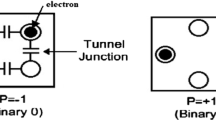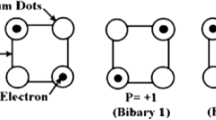Abstract
Today, due to the impossibility of further reducing the dimensions, electronic devices are faced with fundamental challenges in parameters such as speed, frequency, and power consumption for CMOS technology circuit. One solution is to replace CMOS technology with other technologies such as Quantum-dot Cellular Automata (QCA) technology. Extensive researches have been done for design digital circuits in QCA technology. Phase-frequency detector (PFD) is one of the main blocks in electrical and communication systems. In this paper, a structure is presented for a PFD in QCA technology for the first time. In the proposed structure, a D flip-flop (D-FF) with reset ability based on a new inverter gate is used. The new inverter gate of this D-FF compared to previous inverters, has output signal with high polarization level. Also, the proposed PFD has 199 cells, 0.22 μm2 occupied area and two clock cycles latency that is smaller compared with PFD which is designed with the conventional inverter.

















Similar content being viewed by others
References
Lent, C.S., et al.: Quantum cellular automata. Nanotechnology 4(1), 49 (1993)
Seminario, J.M., et al.: A molecular device operating at terahertz frequencies: theoretical simulations. IEEE Trans. Nanotechnol. 3(1), 215–218 (2004)
DeHon, A., Wilson, M.J.: Nanowire-based sublithographic programmable logic arrays. ACM, New York (2004)
Timler, J., Lent, C.S.: Power gain and dissipation in quantum-dot cellular automata. J. Appl. Phys. 91(2), 823–831 (2002)
Razavi, B.: Design of Analog CMOS Integrated Circuits. 2nd edition. McGraw-Hill, New York (2017)
Rahimpour, H., et al.: All digital fast lock DLL-based frequency multiplier. Analog Integr. Circ. Sig. Process 78(3), 819–826 (2014)
Gholami, M., Ardeshir, G.: Jitter of delay-locked loops due to PFD. IEEE Trans. Very Large Scale Integr. Syst. 22(10), 2176–2180 (2014)
Zahmatkesh, M., et al.: Robust coplanar full adder based on novel inverter in quantum cellular automata. Int. J. Theor. Phys. 58(2), 639–655 (2019)
Walus, K., et al.: QCADesigner: a rapid design and simulation tool for quantum-dot cellular automata. IEEE Trans. Nanotechnol. 3(1), 26–31 (2004)
Snider, G.L., et al.: Quantum-dot cellular automata: introduction and experimental overview. IEEE, New Jersey (2001)
Xiao, L.-R., Chen, X.-X., Ying, S.-Y.: Design of dual-edge triggered flip-flops based on quantum-dot cellular automata. J. Zhejiang Univ. Sci. C 13(5), 385–392 (2012)
Binaei, R., Gholami, M.: Design of multiplexer-based D flip-flop with set and reset ability in quantum dot cellular automata nanotechnology. Int. J. Theor. Phys. 58(3), 687–699 (2019)
Roshan, M.G., Gholami, M.: Novel D latches and D flip-flops with set and reset ability in QCA nanotechnology using minimum cells and area. Int. J. Theor. Phys. 57(10), 3223–3241 (2018)
Zoka, S., Gholami, M.: Two novel D-flip flops with level triggered reset in quantum dot cellular automata technology. Int. J. Eng. Trans. C: Asp. 31(3), 415–421 (2017)
Tougaw, P.D., Lent, C.S.: Logical devices implemented using quantum cellular automata. J. Appl. Phys. 75(3), 1818–1825 (1994)
Gin, A., Tougaw, P.D., Williams, S.: An alternative geometry for quantum-dot cellular automata. J. Appl. Phys. 85(12), 8281–8286 (1999)
Amirzadeh, Z., Gholami, M.: Counters designs with minimum number of cells and area in the quantum-dot cellular automata technology. Int. J. Theor. Phys. 58, 1–18 (2019)
Gholami, M.: Phase detector with minimal blind zone and reset time for GSamples/s DLLs. Circuits Syst. Signal Process. 36(9), 3549–3563 (2017)
Sofimowloodi, S., Razaghian, F., Gholami, M.: Low-power high-frequency phase frequency detector for minimal blind-zone phase-locked loops. Circuits Syst. Signal Process. 38(2), 498–511 (2019)
Abutaleb, M.M.: Robust and efficient quantum-dot cellular automata synchronous counters. Microelectron. J. 61, 6–14 (2017)
Srivastava, S., et al.: QCAPro-an error-power estimation tool for QCA circuit design. IEEE, New Jersey (2011)
Author information
Authors and Affiliations
Corresponding author
Additional information
Publisher's Note
Springer Nature remains neutral with regard to jurisdictional claims in published maps and institutional affiliations.
Rights and permissions
About this article
Cite this article
Alamdar, H., Ardeshir, G. & Gholami, M. Phase-frequency detector in QCA nanotechnology using novel flip-flop with reset terminal. Int Nano Lett 10, 111–118 (2020). https://doi.org/10.1007/s40089-020-00300-2
Received:
Accepted:
Published:
Issue Date:
DOI: https://doi.org/10.1007/s40089-020-00300-2




